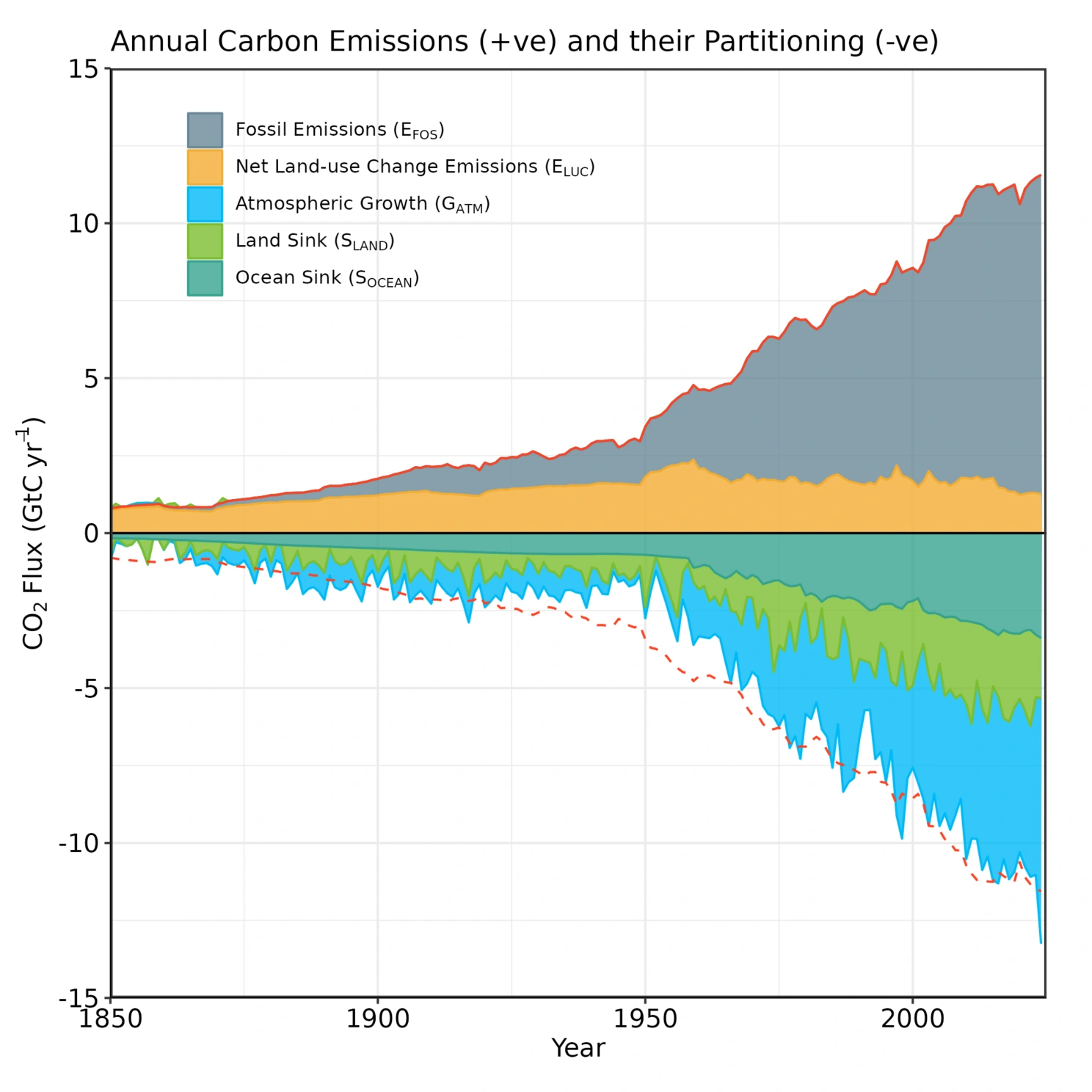Another record year for fossil fuel emissions
Global CO₂ emissions from fossil fuels are projected to be 1.1 % higher in 2025. The ocean CO₂ uptake was re-evaluated based on stronger evidence and new understanding.
Publisert 13. November 2025
Written by Tori Pedersen

The ocean has taken up 29% of the total emissions in the past decade. Photo: Ellen Viste / Bjerknes Centre
The Global Carbon Budget 2025 is released during the climate talks at COP30 in Belém, Brazil, Thursday. This year’s budget projects 38.1 billion tons of fossil carbon dioxide emissions.
Researchers from the University of Bergen, NORCE and the Bjerknes Centre have provided large amounts of data on the state of the world’s oceans, through both observations and models.
More precise result
The ocean CO₂ uptake was re-evaluated based on stronger evidence and new understanding. Using new data and understanding has helped clarify the emergence of climate impacts on the natural CO₂ sinks.
The ocean has taken up 29% of the total emissions in the past decade, compared to 26% in previous budgets.
“Based on new evidence from field and modelling studies, the current budget includes observation-based CO2 data products which have been corrected to the temperature of the skin layer (where the gas exchange takes place) instead of the traditionally used, slightly warmer, bulk sea surface temperature,” says Abdir Omar.
Omar, from NORCE and the Bjerknes Centre, is one of the researchers who has worked on the ocean uptake in this report.

Abdir Omar explains that the ocean CO₂ uptake was re-evaluated by using improved data and new methods. Photo: Andreas R. Graven, NORCE.
Ocean uptake stagnation
Since 2016, the ocean’s ability to absorb CO₂ has been relatively stagnant, mainly due to climate variability disrupting the previous upward trend, and further impacted by the 2023–2024 ocean heatwave in the Northern Hemisphere. The preliminary estimate for 2025 is slightly below the 2024 level following the end of the El Niño conditions.
“Although the ocean has historically been a steadily increasing sink for CO₂, we know there is significant interannual and decadal variability and the uptake can stagnate for time periods. Especially, on decadal time scales, we don’t fully understand the underlying mechanisms of the variability – so surprises can happen," Omar explains.

CO2 emitted by man is exchanged between the atmosphere, the oceans and the Earth's vegetation. This figure shows annual mean values for the period 2015–2024 i GtCO2. Ill.: Global Carbon Budget 2025.
10 years since Paris
As the emissions are projected to rise 1.1% in 2025, they are 10% higher than in 2015, ten years since the Paris Agreement was adopted. Director at the Bjerknes Centre for Climate Research, Kikki Kleiven, has looked at this year’s numbers.
"CO₂ levels in the atmosphere are now rising faster than ever recorded. This means more heat, more extreme weather — and emissions that will shape the climate for hundreds of years to come. We are in the midst of a self-reinforcing development, where nature’s ability to absorb carbon is weakening. If we are to turn this around, we must understand the entire carbon cycle - both emissions and uptake. Knowledge is our most important tool for acting in time”, Kleiven says.

Sources of CO2 emissions and uptake since 1850. Ill: Global Carbon Budget 2025, under the license CC 4.0.
Annual variations
Year-to-year changes in atmospheric CO₂ levels are mainly driven by shifts between El Niño and La Niña conditions in the tropical Pacific. The last El Niño (2023-2024) ended last summer. The land CO₂ sink is set to recover to its pre-El Niño level in 2025, after a strong decrease in 2024, the report states.
Meaning the Earth's land-based systems have regained their ability to absorb CO₂ from the atmosphere to the level they had before the 2023-2024 El Niño event. These systems often become less effective at absorbing CO₂ due to changes in temperature and rainfall.
In 2025, carbon emissions from China and India are expected to grow more slowly than they have in recent years. Although global fossil CO₂ emissions have continued to rise overall, 35 countries achieved a statistically significant decline, representing 27% of global fossil CO₂ emissions over the past decade (2015–2024).
Meanwhile, emissions in the United States and the European Union are expected to increase this year — partly due to weather conditions.
Almost there
The report says the remaining carbon budget to limit global warming to 1.5% is “virtually exhausted”. At the current rate of emissions, the team estimates a one-in-two chance that four more years of current CO₂ emissions would bring global warming to 1.5°C.
“We can realistically just say goodbye to the 1.5-degree target. If we keep going as we do now, we might have four years left, and then we’ll be past 1.5 degrees. The conclusion of the bad news is simply that we are still not in a position to uphold the Paris Agreement”, Omar says.
Global carbon budget
The Global Carbon Budget is the yearly assessment of carbon emissions and absorption across the planet, produced through collaboration among international scientists who monitor and calculate carbon sources and sinks in the Earth system.
The climate research environment in Bergen - including UiB, NORCE, and the Bjerknes Centre — has provided large amounts of data on the state of the world’s oceans, through both observations and models.
The project ICOS Norway has played a central role. The data extends all the way back to the 1990s, and with the help of models, researchers can calculate conditions going back to pre-industrial times.
Read more at: https://globalcarbonbudget.org/
References
The Global Carbon Budget
Emerging climate impact on carbon sinks in a consolidated carbon budget